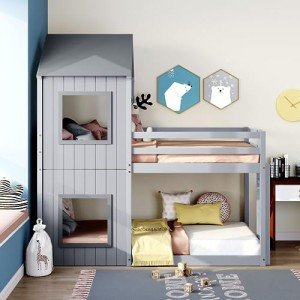Exploring Bunk Beds: A Comprehensive Guide
Bunk beds have long been a staple in children's bedrooms, dorm rooms, and even homes with limited space. Not only do they provide a practical sleeping solution, but they likewise produce an enjoyable and imaginative environment for kids and a great space-saver for adults and families. This post will explore everything you require to understand about bunk beds, from types and materials to safety suggestions and purchasing advice.
Table of Contents
- Types of Bunk Beds
- Traditional Bunk Beds
- Loft Beds
- Triple Bunk Beds
- L-Shaped Bunk Beds
- Material Options
- Wood
- Metal
- Security Considerations
- Buying Guide
- FAQs
Types of Bunk Beds
Bunk beds come in different styles to match different requirements and choices. Here's a breakdown of the most typical types:
Conventional Bunk Beds
Standard bunks normally include 2 beds stacked vertically on top of one another. These beds are perfect for siblings sharing a space or for optimizing sleeping space in visitor rooms.
Loft Beds
Loft beds stand likewise to conventional bunk beds however do not have a lower sleeping location. Rather, they often include a desk or seating area below, making them a great choice for little spaces requiring multifunctionality.
Triple Bunk Beds
Triple bunk beds are designed for three occupants, with beds stacked in a three-tier configuration. These are less common but can be an enjoyable solution for big families or pajama parties.
L-Shaped Bunk Beds
With one bed positioned horizontally and the other vertically, L-shaped bunk beds are frequently equipped with additional functions such as desks or storage drawers and can complement corner areas in a space.
Contrast of Bunk Bed Types
| Bed Type | Perfect Use | Description |
|---|---|---|
| Standard | Shared bed rooms or guest rooms | 2 beds stacked vertically |
| Loft | Little spaces requiring multi-purpose space | Upper bed with open space below |
| Triple | Large families or pajama parties | 3 beds stacked vertically |
| L-Shaped | Corner or flexible spaces | A combination of vertical and horizontal beds |
Product Options
Bunk beds are produced from various materials, with wood and metal being the most typical. Each material has its benefits and drawbacks.
Wood
- Durability: Generally robust and can endure years of use.
- Aesthetic Appeal: Offers a timeless look that can blend with numerous decors.
- Weight Capacity: Typically sturdier; can support heavier weights.
- Disadvantages: May be more costly than metal options and can be susceptible to scratches.
Metal
- Sturdiness: Generally lightweight and simple to move but still tough.
- Modern Design: Often is available in smooth styles, making it appealing for contemporary areas.
- Affordable: Usually less expensive than wood choices.
- Downsides: Can be cold to the touch in winter seasons and might not have the exact same visual appeal for some purchasers.
Safety Considerations
When it pertains to bunk beds, safety can not be ignored. Here are essential safety pointers to keep in mind:
- Guardrails: Ensure that the top bunk has guardrails on both sides to prevent falls.
- Sturdy Construction: Check for a solid develop and tough products to endure weight and motion.
- Weight Limit: Adhere to the maker's weight limitation for both the upper and lower bunks.
- Ladder Design: Choose bunks with a safe, easy-to-climb ladder and prevent any sharp edges or rungs.
- Age Restrictions: Most manufacturers recommend that kids under the age of 6 must not sleep in the upper bunk.
Purchasing Guide
When searching for bunk beds, consider the following elements to find the very best suitable for your requirements:
- Space Availability: Measure the space size and ceiling height, guaranteeing there is sufficient space for the leading bunk.
- Bed Size: Decide in between twin, complete, or bigger sizes based upon your needs and the size of the space.
- Style Preference: Consider the overall decoration of the bedroom to find an ideal design.
- Relieve of Setup: Look for a bunk bed that is uncomplicated to put together.
- Budget: Bunk beds come in various cost ranges, so figure out a spending plan before starting your search.
FAQs
1. What is additional resources advised age for children to sleep on the leading bunk?
Children aged 6 and older are generally recommended to sleep on the top bunk to decrease the risk of falls.
2. How can I make my bunk bed much safer?
To boost safety, guarantee guardrails are correctly set up and check that the bed is put on a flat surface area. Furthermore, motivate children to utilize the ladder carefully.
3. Can I transform a bunk bed into two separate beds?
Many bunk beds are created to be convertible. Inspect the producer's specifications for convertibility features.
4. What devices are available for bunk beds?
Typical devices include beddings, storage drawers, staircases instead of ladders, and tented canopies for a fun visual appeal.
5. How do I preserve my bunk bed?
Regular look for loose screws or structural stability can assist guarantee security. Dust the bed frequently and tidy spills without delay to keep the materials in good condition.
Bunk beds are versatile and a space-efficient service for various living scenarios, from kids's spaces to guest accommodations. With many designs and products offered, potential buyers have a wealth of alternatives to think about, making sure a combination of functionality and looks. By prioritizing safety and following the suggestions outlined in this guide, people can discover the ideal bunk bed that matches their space and way of life, all while producing an enjoyable sleeping environment.

